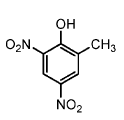|
Definition: "An ergogenic aid is any substance or phenomenon that enhances performance "
|
|
||||||||
10.06.2009 |
|
|
Dinitrocresol, the dreaded brother of killer drug DNP
Risky and illegal dinitrophenol (DNP) has a close chemical relative which, like DNP, was marketed in the 1930s as a legal slimming aid. Dinitrocresol was five times stronger than DNP, writes Eric Colman of the FDA in an article on its history in Regulatory Toxicology and Pharmacology.
This discovery inspired the American doctor Maurice Tainter to do tests on overweight people in the 1930s. In the tests DNP raised the subjects' metabolism to fifty percent, as you can read in the review article Use of Dinitrophenol in Nutritional Disorders: A Critical Survey of Clinical Results, which Tainter published in 1934. [Am J Public Health Nations Health. 1934 Oct;24(10):1045-53.] In Tainter's study fat people lost up to one and a half kilograms of fat per week with daily doses of about 350 mg of DNP. DNP turned out to be a more effective slimming aid than thyroxin, which doctors had been experimenting with at that time. DNP increased the body's heat production by 1200 percent.
DNP deactivates the enzyme that stores energy, which is generated in the cell from fatty acids and sugars, in ATP. Instead the energy is released as heat.
Tainter published the results of his research in 1933. On 7 February 1934 Isabella Laboratories, owned by the advertiser Harry Goroy, produced the first batch of supplements that contained DNP as the active ingredient. The product was called Formula 281, and a capsule contained 100 mg of DNP. "At last a slimming aid that will give you a figure that men will love and women will be jealous of. No danger to your health! No need to change your lifestyle!", the adverts claimed.
DNP caught on. A few of the slimming aids based on DNP are shown above. In the same year Tainter estimated that a hundred thousand Americans had already used DNP within a few months of its launch. Products containing the miracle compound appeared all over the world.
Dinitrocresol was five times stronger than DNP. Just before Isabella Laboratories started adding the substance to its supplements, an article appeared in The Lancet in which British researchers showed that dinitrocresol was an even more effective metabolic stimulant than DNP. A daily dose of 240 mg raised metabolism by seventy percent within a few days, according to the Brits. [Lancet 1933,2(67):1137-9.]
"It literally burns fat away," claimed an ad. "Absolutely no side effects". Apart from a skin rash, or change in skin colour or in the eyes. But if you did experience any of these all you had to do was drink a glass of water with sodium bicarbonate and voila! Problem solved.
Dinitrocresol was as successful as DNP. In 1935 Isabella Labs sold 550,000 capsules. Products started to appear that contained both substances as active ingredients.
Meanwhile it was becoming clear that DNP and dinitrocresol weren't actually that safe. There were a couple of deaths. Supporters of DNP thought that the deaths were due to overdoses, taken by stubborn and impatient users who didn't follow the dosage instructions. Warner Horner, an optician, dashed these hopes when he discovered users who had become blind after taking DNP, which they had done under guidance from a physician. Horner estimated in 1936 that 2500 Americans had turned blind from taking DNP. [Trans Am Ophthalmol Soc. 1941;39:405-37.]
The FDA contacted Isabella Laboratories in 1936 and asked the company to stop producing DNP supplements. Legally speaking, Formula 281 was not a medicine. It was for fighting obesity and, according to doctors at the time, obesity was not a disease. The FDA had powers to regulate sales of medicines, but not sales of supplements. It wasn't until 1937, by which time Isabella Laboratories had made its advertising claims so extravagant that Formula 281 could be legally considered a medicine, that the FDA was able to do something about the situation. Formula 281 and Improved Formula 281 disappeared from the market, and in 1938 Harry Goroy paid a fine of 50,000 dollars.
The DNP era had passed. For the time being.
Source:
More:
|
|




